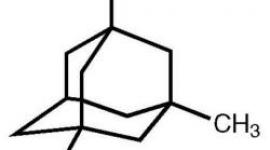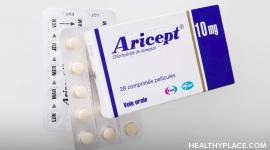Exelon: Cholinesterase Inhibitor
Exelon is a cholinesterase Inhibitor used in the treatment of Alzheimer's Disease. Usage, dosage, side-effects of Exelon.
Brand Name: Exelon
Generic Name: rivastigmine tartrate
Exelon (rivastigmine tartrate) is an Cholinesterase Inhibitor used in treatment of Alzheimer's Disease. Detailed info on uses, dosage and side-effects of Exelon below.
Contents:
Description
Pharmacology
Indications and Usage
Contraindications
Warnings
Precautions
Drug Interactions
Adverse Reactions
Overdose
Dosage
Supplied
Instructions for Use
Exelon patient information (in plain English)
Description
Exelon® (rivastigmine tartrate) is a reversible cholinesterase inhibitor and is known chemically as (S)-N-Ethyl-N-methyl-3-[1-(dimethylamino)ethyl]-phenyl carbamate hydrogen-(2R,3R)-tartrate. Rivastigmine tartrate is commonly referred to in the pharmacological literature as SDZ ENA 713 or ENA 713. It has an empirical formula of C 14 H 22 N 2 O 2 · C 4 H 6 O 6 (hydrogen tartrate salt - hta salt) and a molecular weight of 400.43 (hta salt). Rivastigmine tartrate is a white to off-white, fine crystalline powder that is very soluble in water, soluble in ethanol and acetonitrile, slightly soluble in n-octanol and very slightly soluble in ethyl acetate. The distribution coefficient at 37°C in n-octanol/phosphate buffer solution pH 7 is 3.0.
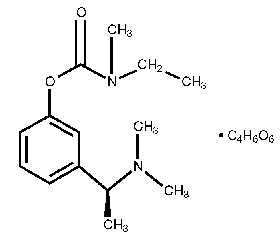
Exelon is supplied as capsules containing rivastigmine tartrate, equivalent to 1.5, 3, 4.5 and 6 mg of rivastigmine base for oral administration. Inactive ingredients are hydroxypropyl methylcellulose, magnesium stearate, microcrystalline cellulose, and silicon dioxide. Each hard-gelatin capsule contains gelatin, titanium dioxide and red and/or yellow iron oxides.
Exelon Oral Solution is supplied as a solution containing rivastigmine tartrate, equivalent to 2 mg/mL of rivastigmine base for oral administration. Inactive ingredients are citric acid, D&C yellow #10, purified water, sodium benzoate and sodium citrate.
Clinical Pharmacology
Mechanism of Action
Pathological changes in Dementia of the Alzheimer type involve cholinergic neuronal pathways that project from the basal forebrain to the cerebral cortex and hippocampus. These pathways are thought to be intricately involved in memory, attention, learning, and other cognitive processes. While the precise mechanism of rivastigmine's action is unknown, it is postulated to exert its therapeutic effect by enhancing cholinergic function. This is accomplished by increasing the concentration of acetylcholine through reversible inhibition of its hydrolysis by cholinesterase. If this proposed mechanism is correct, Exelon's effect may lessen as the disease process advances and fewer cholinergic neurons remain functionally intact. There is no evidence that rivastigmine alters the course of the underlying dementing process. After a 6-mg dose of rivastigmine, anticholinesterase activity is present in CSF for about 10 hours, with a maximum inhibition of about 60% five hours after dosing.
In vitro and in vivo studies demonstrate that the inhibition of cholinesterase by rivastigmine is not affected by the concomitant administration of memantine, an N-methyl-D-aspartate receptor antagonist.
Clinical Trial Data
The effectiveness of Exelon® (rivastigmine tartrate) as a treatment for Alzheimer's Disease is demonstrated by the results of two randomized, double-blind, placebo-controlled clinical investigations in patients with Alzheimer's Disease [diagnosed by NINCDS-ADRDA and DSM-IV criteria, Mini-Mental State Examination (MMSE) >/=10 and <!--=26, and the Global Deterioration Scale (GDS)]. The mean age of patients participating in Exelon trials was 73 years with a range of 41-95. Approximately 59% of patients were women and 41% were men. The racial distribution was Caucasian 87%, Black 4% and Other races 9%.
Study Outcome Measures: In each study, the effectiveness of Exelon was evaluated using a dual outcome assessment strategy.
The ability of Exelon to improve cognitive performance was assessed with the cognitive subscale of the Alzheimer's Disease Assessment Scale (ADAS-cog), a multi-item instrument that has been extensively validated in longitudinal cohorts of Alzheimer's Disease patients. The ADAS-cog examines selected aspects of cognitive performance including elements of memory, orientation, attention, reasoning, language and praxis. The ADAS-cog scoring range is from 0 to 70, with higher scores indicating greater cognitive impairment. Elderly normal adults may score as low as 0 or 1, but it is not unusual for non-demented adults to score slightly higher.
The patients recruited as participants in each study had mean scores on ADAS-cog of approximately 23 units, with a range from 1 to 61. Experience gained in longitudinal studies of ambulatory patients with mild to moderate Alzheimer's Disease suggest that they gain 6-12 units a year on the ADAS-cog. Lesser degrees of change, however, are seen in patients with very mild or very advanced disease because the ADAS-cog is not uniformly sensitive to change over the course of the disease. The annualized rate of decline in the placebo patients participating in Exelon trials was approximately 3-8 units per year.
The ability of Exelon to produce an overall clinical effect was assessed using a Clinician's Interview Based Impression of Change that required the use of caregiver information, the CIBIC-Plus. The CIBIC-Plus is not a single instrument and is not a standardized instrument like the ADAS-cog. Clinical trials for investigational drugs have used a variety of CIBIC formats, each different in terms of depth and structure. As such, results from a CIBIC-Plus reflect clinical experience from the trial or trials in which it was used and can not be compared directly with the results of CIBIC-Plus evaluations from other clinical trials. The CIBIC-Plus used in the Exelon trials was a structured instrument based on a comprehensive evaluation at baseline and subsequent time-points of three domains: patient cognition, behavior and functioning, including assessment of activities of daily living. It represents the assessment of a skilled clinician using validated scales based on his/her observation at interviews conducted separately with the patient and the caregiver familiar with the behavior of the patient over the interval rated. The CIBIC-Plus is scored as a seven point categorical rating, ranging from a score of 1, indicating "markedly improved," to a score of 4, indicating "no change" to a score of 7, indicating "marked worsening." The CIBIC-Plus has not been systematically compared directly to assessments not using information from caregivers (CIBIC) or other global methods.
U.S. Twenty-Six-Week Study
In a study of 26 weeks duration, 699 patients were randomized to either a dose range of 1-4 mg or 6-12 mg of Exelon per day or to placebo, each given in divided doses. The 26-week study was divided into a 12-week forced dose titration phase and a 14-week maintenance phase. The patients in the active treatment arms of the study were maintained at their highest tolerated dose within the respective range.
Effects on the ADAS-cog: Figure 1 illustrates the time course for the change from baseline in ADAS-cog scores for all three dose groups over the 26 weeks of the study. At 26 weeks of treatment, the mean differences in the ADAS-cog change scores for the Exelon-treated patients compared to the patients on placebo were 1.9 and 4.9 units for the 1-4 mg and 6-12 mg treatments, respectively. Both treatments were statistically significantly superior to placebo and the 6-12 mg/day range was significantly superior to the 1-4 mg/day range.

Figure 2 illustrates the cumulative percentages of patients from each of the three treatment groups who had attained at least the measure of improvement in ADAS-cog score shown on the X axis. Three change scores, (7-point and 4-point reductions from baseline or no change in score) have been identified for illustrative purposes, and the percent of patients in each group achieving that result is shown in the inset table.
The curves demonstrate that both patients assigned to Exelon and placebo have a wide range of responses, but that the Exelon groups are more likely to show the greater improvements. A curve for an effective treatment would be shifted to the left of the curve for placebo, while an ineffective or deleterious treatment would be superimposed upon, or shifted to the right of the curve for placebo, respectively.
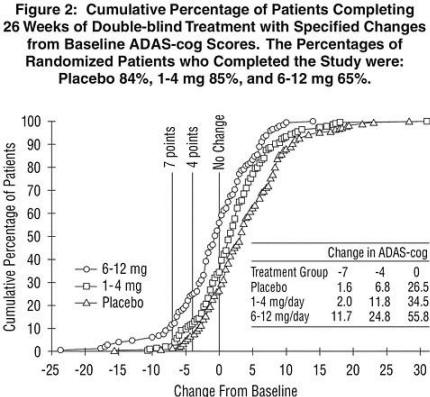
Effects on the CIBIC-Plus: Figure 3 is a histogram of the frequency distribution of CIBIC-Plus scores attained by patients assigned to each of the three treatment groups who completed 26 weeks of treatment. The mean Exelon-placebo differences for these groups of patients in the mean rating of change from baseline were 0.32 units and 0.35 units for 1-4 mg and 6-12 mg of Exelon, respectively. The mean ratings for the 6-12 mg/day and 1-4 mg/day groups were statistically significantly superior to placebo. The differences between the 6-12 mg/day and the 1-4 mg/day groups were statistically significant.
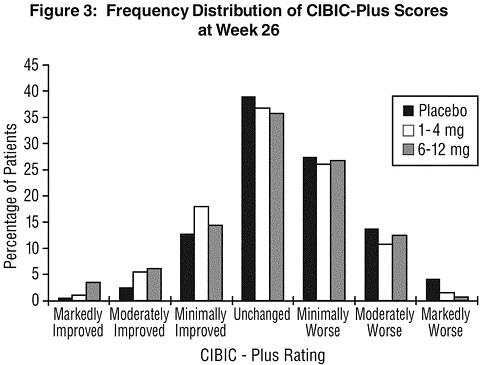
Global Twenty-Six-Week Study
In a second study of 26 weeks duration, 725 patients were randomized to either a dose range of 1-4 mg or 6-12 mg of Exelon per day or to placebo, each given in divided doses. The 26-week study was divided into a 12-week forced dose titration phase and a 14-week maintenance phase. The patients in the active treatment arms of the study were maintained at their highest tolerated dose within the respective range.
Effects on the ADAS-cog: Figure 4 illustrates the time course for the change from baseline in ADAS-cog scores for all three dose groups over the 26 weeks of the study. At 26 weeks of treatment, the mean differences in the ADAS-cog change scores for the Exelon-treated patients compared to the patients on placebo were 0.2 and 2.6 units for the 1-4 mg and 6-12 mg treatments, respectively. The 6-12 mg/day group was statistically significantly superior to placebo, as well as to the 1-4 mg/day group. The difference between the 1-4 mg/day group and placebo was not statistically significant.
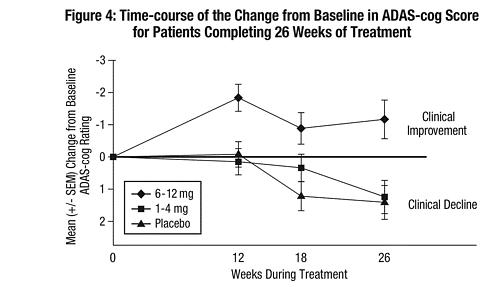
Figure 5 illustrates the cumulative percentages of patients from each of the three treatment groups who had attained at least the measure of improvement in ADAS-cog score shown on the X axis. Similar to the U.S. 26-week study, the curves demonstrate that both patients assigned to Exelon and placebo have a wide range of responses, but that the 6-12 mg/day Exelon group is more likely to show the greater improvements.
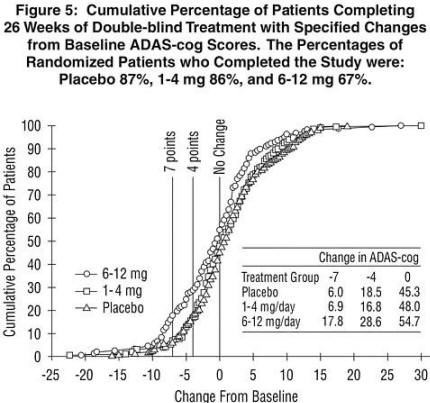
Effects on the CIBIC-Plus: Figure 6 is a histogram of the frequency distribution of CIBIC-Plus scores attained by patients assigned to each of the three treatment groups who completed 26 weeks of treatment. The mean Exelon-placebo differences for these groups of patients for the mean rating of change from baseline were 0.14 units and 0.41 units for 1-4 mg and 6-12 mg of Exelon, respectively. The mean ratings for the 6-12 mg/day group was statistically significantly superior to placebo. The comparison of the mean ratings for the 1-4 mg/day group and placebo group was not statistically significant.
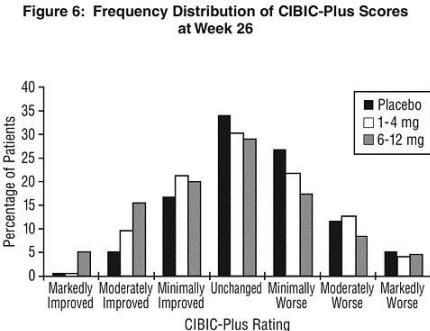
U.S. Fixed Dose Study
In a study of 26 weeks duration, 702 patients were randomized to doses of 3, 6, or 9 mg/day of Exelon or to placebo, each given in divided doses. The fixed-dose study design, which included a 12-week forced titration phase and a 14-week maintenance phase, led to a high dropout rate in the 9 mg/day group because of poor tolerability. At 26 weeks of treatment, significant differences were observed for the ADAS-cog mean change from baseline for the 9 mg/day and 6 mg/day groups, compared to placebo. No significant differences were observed between any of the Exelon dose groups and placebo for the analysis of the CIBIC-Plus mean rating of change. Although no significant differences were observed between Exelon treatment groups, there was a trend toward numerical superiority with higher doses.
Age, Gender and Race: Patient's age, gender, or race did not predict clinical outcome to Exelon treatment.
Pharmacokinetics
Rivastigmine is well absorbed with absolute bioavailability of about 40% (3-mg dose). It shows linear pharmacokinetics up to 3 mg BID but is non-linear at higher doses. Doubling the dose from 3 to 6 mg BID results in a 3-fold increase in AUC. The elimination half-life is about 1.5 hours, with most elimination as metabolites via the urine.
Absorption: Rivastigmine is rapidly and completely absorbed. Peak plasma concentrations are reached in approximately 1 hour. Absolute bioavailability after a 3-mg dose is about 36%. Administration of Exelon with food delays absorption (t max ) by 90 min, lowers C max by approximately 30% and increases AUC by approximately 30%.
Distribution: Rivastigmine is widely distributed throughout the body with a volume of distribution in the range of 1.8-2.7 L/kg. Rivastigmine penetrates the blood brain barrier, reaching CSF peak concentrations in 1.4-2.6 hours. Mean AUC 1-12hr ratio of CSF/plasma averaged 40 ± 0.5% following 1-6 mg BID doses.
Rivastigmine is about 40% bound to plasma proteins at concentrations of 1-400 ng/mL, which cover the therapeutic concentration range. Rivastigmine distributes equally between blood and plasma with a blood-to-plasma partition ratio of 0.9 at concentrations ranging from 1-400 ng/mL.
Metabolism: Rivastigmine is rapidly and extensively metabolized, primarily via cholinesterase-mediated hydrolysis to the decarbamylated metabolite. Based on evidence from in vitro and animal studies the major cytochrome P450 isozymes are minimally involved in rivastigmine metabolism. Consistent with these observations is the finding that no drug interactions related to cytochrome P450 have been observed in humans (see Drug-Drug Interactions ).
Elimination: The major pathway of elimination is via the kidneys. Following administration of 14 C-rivastigmine to 6 healthy volunteers total recovery of radioactivity over 120 hours was 97% in urine and 0.4% in feces. No parent drug was detected in urine. The sulfate conjugate of the decarbamylated metabolite is the major component excreted in urine and represents 40% of the dose. Mean oral clearance of rivastigmine is 1.8 ± 0.6 L/min after 6 mg BID.
Special Populations
Hepatic Disease: Following a single 3-mg dose, mean oral clearance of rivastigmine was 60% lower in hepatically impaired patients (n=10, biopsy proven) than in healthy subjects (n=10). After multiple 6 mg BID oral dosing, the mean clearance of rivastigmine was 65% lower in mild (n=7, Child-Pugh score 5-6) and moderate (n=3, Child-Pugh score 7-9) hepatically impaired patients (biopsy proven, liver cirrhosis) than in healthy subjects (n=10). Dosage adjustment is not necessary in hepatically impaired patients as the dose of drug is individually titrated to tolerability.
Renal Disease: Following a single 3-mg dose, mean oral clearance of rivastigmine is 64% lower in moderately impaired renal patients (n=8, GFR=10-50 mL/min) than in healthy subjects (n=10, GFR>/=60 mL/min); Cl/F=1.7 L/min (cv=45%) and 4.8 L/min (cv=80%), respectively. In severely impaired renal patients (n=8, GFR/=60 mL/min); Cl/F=6.9 L/min and 4.8 L/min, respectively. For unexplained reasons, the severely impaired renal patients had a higher clearance of rivastigmine than moderately impaired patients. However, dosage adjustment may not be necessary in renally impaired patients as the dose of the drug is individually titrated to tolerability.
Age: Following a single 2.5 mg oral dose to elderly volunteers (>60 years of age, n=24) and younger volunteers (n=24), mean oral clearance of rivastigmine was 30% lower in elderly (7 L/min) than in younger subjects (10 L/min).
Gender and Race: No specific pharmacokinetic study was conducted to investigate the effect of gender and race on the disposition of Exelon, but a population pharmacokinetic analysis indicates that gender (n=277 males and 348 females) and race (n=575 White, 34 Black, 4 Asian, and 12 Other) did not affect the clearance of Exelon.
Nicotine Use: Population PK analysis showed that nicotine use increases the oral clearance of rivastigmine by 23% (n=75 Smokers and 549 Nonsmokers).
Drug-Drug Interactions
Effect of Exelon on the Metabolism of Other Drugs: Rivastigmine is primarily metabolized through hydrolysis by esterases. Minimal metabolism occurs via the major cytochrome P450 isoenzymes. Based on in vitro studies, no pharmacokinetic drug interactions with drugs metabolized by the following isoenzyme systems are expected: CYP1A2, CYP2D6, CYP3A4/5, CYP2E1, CYP2C9, CYP2C8, or CYP2C19.
No pharmacokinetic interaction was observed between rivastigmine and digoxin, warfarin, diazepam, or fluoxetine in studies in healthy volunteers. The elevation of prothrombin time induced by warfarin is not affected by administration of Exelon.
Effect of Other Drugs on the Metabolism of Exelon: Drugs that induce or inhibit CYP450 metabolism are not expected to alter the metabolism of rivastigmine. Single dose pharmacokinetic studies demonstrated that the metabolism of rivastigmine is not significantly affected by concurrent administration of digoxin, warfarin, diazepam, or fluoxetine.
Population PK analysis with a database of 625 patients showed that the pharmacokinetics of rivastigmine were not influenced by commonly prescribed medications such as antacids (n=77), antihypertensives (n=72), (beta)-blockers (n=42), calcium channel blockers (n=75), antidiabetics (n=21), nonsteroidal anti-inflammatory drugs (n=79), estrogens (n=70), salicylate analgesics (n=177), antianginals (n=35), and antihistamines (n=15). In addition, in clinical trials, no increased risk of clinically relevant untoward effects was observed in patients treated concomitantly with Exelon and these agents.
Indications and Usage
Exelon® (rivastigmine tartrate) is indicated for the treatment of mild to moderate dementia of the Alzheimer's type.
Contraindications
Exelon® (rivastigmine tartrate) is contraindicated in patients with known hypersensitivity to rivastigmine, other carbamate derivatives or other components of the formulation (see DESCRIPTION ).
Warnings
Gastrointestinal Adverse Reactions
Exelon ® (rivastigmine tartrate) use is associated with significant gastrointestinal adverse reactions, including nausea and vomiting, anorexia, and weight loss. For this reason, patients should always be started at a dose of 1.5 mg BID and titrated to their maintenance dose. If treatment is interrupted for longer than several days, treatment should be reinitiated with the lowest daily dose (see DOSAGE AND ADMINISTRATION ) to reduce the possibility of severe vomiting and its potentially serious sequelae (e.g., there has been one post-marketing report of severe vomiting with esophageal rupture following inappropriate reinitiation of treatment with a 4.5-mg dose after 8 weeks of treatment interruption).
Nausea and Vomiting: In the controlled clinical trials, 47% of the patients treated with an Exelon dose in the therapeutic range of 6-12 mg/day (n=1189) developed nausea (compared with 12% in placebo). A total of 31% of Exelon-treated patients developed at least one episode of vomiting (compared with 6% for placebo). The rate of vomiting was higher during the titration phase (24% vs. 3% for placebo) than in the maintenance phase (14% vs. 3% for placebo). The rates were higher in women than men. Five percent of patients discontinued for vomiting, compared to less than 1% for patients on placebo. Vomiting was severe in 2% of Exelon-treated patients and was rated as mild or moderate each in 14% of patients. The rate of nausea was higher during the titration phase (43% vs. 9% for placebo) than in the maintenance phase (17% vs. 4% for placebo).
Weight Loss: In the controlled trials, approximately 26% of women on high doses of Exelon (greater than 9 mg/day) had weight loss of equal to or greater than 7% of their baseline weight compared to 6% in the placebo-treated patients. About 18% of the males in the high dose group experienced a similar degree of weight loss compared to 4% in placebo-treated patients. It is not clear how much of the weight loss was associated with anorexia, nausea, vomiting, and the diarrhea associated with the drug.
Anorexia: In the controlled clinical trials, of the patients treated with an Exelon dose of 6-12 mg/day, 17% developed anorexia compared to 3% of the placebo patients. Neither the time course or the severity of the anorexia is known.
Peptic Ulcers/Gastrointestinal Bleeding: Because of their pharmacological action, cholinesterase inhibitors may be expected to increase gastric acid secretion due to increased cholinergic activity. Therefore, patients should be monitored closely for symptoms of active or occult gastrointestinal bleeding, especially those at increased risk for developing ulcers, e.g., those with a history of ulcer disease or those receiving concurrent non-steroidal anti-inflammatory drugs (NSAIDS). Clinical studies of Exelon have shown no significant increase, relative to placebo, in the incidence of either peptic ulcer disease or gastrointestinal bleeding.
Anesthesia
Exelon as a cholinesterase inhibitor, is likely to exaggerate succinylcholine-type muscle relaxation during anesthesia.
Cardiovascular Conditions
Drugs that increase cholinergic activity may have vagotonic effects on heart rate (e.g., bradycardia). The potential for this action may be particularly important to patients with "sick sinus syndrome" or other supraventricular cardiac conduction conditions. In clinical trials, Exelon was not associated with any increased incidence of cardiovascular adverse events, heart rate or blood pressure changes, or ECG abnormalities. Syncopal episodes have been reported in 3% of patients receiving 6-12 mg/day of Exelon, compared to 2% of placebo patients.
Genitourinary
Although this was not observed in clinical trials of Exelon, drugs that increase cholinergic activity may cause urinary obstruction.
Neurological Conditions
Seizures: Drugs that increase cholinergic activity are believed to have some potential for causing seizures. However, seizure activity also may be a manifestation of Alzheimer's Disease.
Pulmonary Conditions
Like other drugs that increase cholinergic activity, Exelon should be used with care in patients with a history of asthma or obstructive pulmonary disease.
Precautions
Information for Patients and Caregivers Caregivers should be advised of the high incidence of nausea and vomiting associated with the use of the drug along with the possibility of anorexia and weight loss. Caregivers should be encouraged to monitor for these adverse events and inform the physician if they occur. It is critical to inform caregivers that if therapy has been interrupted for more than several days, the next dose should not be administered until they have discussed this with the physician.
Caregivers should be instructed in the correct procedure for administering Exelon® (rivastigmine tartrate) Oral Solution. In addition, they should be informed of the existence of an Instruction Sheet (included with the product) describing how the solution is to be administered. They should be urged to read this sheet prior to administering Exelon Oral Solution. Caregivers should direct questions about the administration of the solution to either their physician or pharmacist.
Drug-Drug Interactions
Effect of Exelon ® on the Metabolism of Other Drugs: Rivastigmine is primarily metabolized through hydrolysis by esterases. Minimal metabolism occurs via the major cytochrome P450 isoenzymes. Based on in vitro studies, no pharmacokinetic drug interactions with drugs metabolized by the following isoenzyme systems are expected: CYP1A2, CYP2D6, CYP3A4/5, CYP2E1, CYP2C9, CYP2C8, or CYP2C19.
No pharmacokinetic interaction was observed between rivastigmine and digoxin, warfarin, diazepam, or fluoxetine in studies in healthy volunteers. The elevation of prothrombin time induced by warfarin is not affected by administration of Exelon.
Effect of Other Drugs on the Metabolism of Exelon: Drugs that induce or inhibit CYP450 metabolism are not expected to alter the metabolism of rivastigmine. Single dose pharmacokinetic studies demonstrated that the metabolism of rivastigmine is not significantly affected by concurrent administration of digoxin, warfarin, diazepam, or fluoxetine.
Population PK analysis with a database of 625 patients showed that the pharmacokinetics of rivastigmine were not influenced by commonly prescribed medications such as antacids (n=77), antihypertensives (n=72), (beta)-blockers (n=42), calcium channel blockers (n=75), antidiabetics (n=21), nonsteroidal anti-inflammatory drugs (n=79), estrogens (n=70), salicylate analgesics (n=177), antianginals (n=35), and antihistamines (n=15).
Use with Anticholinergics: Because of their mechanism of action, cholinesterase inhibitors have the potential to interfere with the activity of anticholinergic medications.
Use with Cholinomimetics and Other Cholinesterase Inhibitors: A synergistic effect may be expected when cholinesterase inhibitors are given concurrently with succinylcholine, similar neuromuscular blocking agents or cholinergic agonists such as bethanechol.
Carcinogenesis, Mutagenesis, Impairment of Fertility
In carcinogenicity studies conducted at dose levels up to 1.1 mg-base/kg/day in rats and 1.6 mg-base/kg/day in mice, rivastigmine was not carcinogenic. These dose levels are approximately 0.9 times and 0.7 times the maximum recommended human daily dose of 12 mg/day on a mg/m 2 basis.
Rivastigmine was clastogenic in two in vitro assays in the presence, but not the absence, of metabolic activation. It caused structural chromosomal aberrations in V79 Chinese hamster lung cells and both structural and numerical (polyploidy) chromosomal aberrations in human peripheral blood lymphocytes. Rivastigmine was not genotoxic in three in vitro assays: the Ames test, the unscheduled DNA synthesis (UDS) test in rat hepatocytes (a test for induction of DNA repair synthesis), and the HGPRT test in V79 Chinese hamster cells. Rivastigmine was not clastogenic in the in vivo mouse micronucleus test.
Rivastigmine had no effect on fertility or reproductive performance in the rat at dose levels up to 1.1 mg-base/kg/day. This dose is approximately 0.9 times the maximum recommended human daily dose of 12 mg/day on a mg/m 2 basis.
Pregnancy Pregnancy Category B: Reproduction studies conducted in pregnant rats at doses up to 2.3 mg-base/kg/day (approximately 2 times the maximum recommended human dose on a mg/m 2 basis) and in pregnant rabbits at doses up to 2.3 mg-base/kg/day (approximately 4 times the maximum recommended human dose on a mg/m 2 basis) revealed no evidence of teratogenicity. Studies in rats showed slightly decreased fetal/pup weights, usually at doses causing some maternal toxicity; decreased weights were seen at doses which were several fold lower than the maximum recommended human dose on a mg/m 2 basis. There are no adequate or well-controlled studies in pregnant women. Because animal reproduction studies are not always predictive of human response, Exelon should be used during pregnancy only if the potential benefit justifies the potential risk to the fetus.
Nursing Mothers
It is not known whether rivastigmine is excreted in human breast milk. Exelon has no indication for use in nursing mothers.
Pediatric Use There are no adequate and well-controlled trials documenting the safety and efficacy of Exelon in any illness occurring in children.
Adverse Reactions
Adverse Events Leading to Discontinuation The rate of discontinuation due to adverse events in controlled clinical trials of Exelon® (rivastigmine tartrate) was 15% for patients receiving 6-12 mg/day compared to 5% for patients on placebo during forced weekly dose titration. While on a maintenance dose, the rates were 6% for patients on Exelon compared to 4% for those on placebo.
The most common adverse events leading to discontinuation, defined as those occurring in at least 2% of patients and at twice the incidence seen in placebo patients, are shown in Table 1.
| Study Phase | Titration | Maintenance | Overall | |||
| Placebo (n=868) | Exelon >/=6-12 mg/day (n=1,189) | Placebo (n=788) | Exelon >/=6-12 mg/day (n=987) | Placebo (n=868) | Exelon >/=6-12 mg/day (n=1,189) | |
| Event/% Discontinuing | ||||||
| Nausea | <1 | 8 | <1 | 1 | 1 | 8 |
| Vomiting | <1 | 4 | <1 | 1 | <1 | 5 |
| Anorexia | 0 | 2 | <1 | 1 | <1 | 3 |
| Dizziness | <1 | 2 | <1 | 1 | <1 | 2 |
Most Frequent Adverse Clinical Events Seen in Association with the Use of Exelon
The most common adverse events, defined as those occurring at a frequency of at least 5% and twice the placebo rate, are largely predicted by Exelon's cholinergic effects. These include nausea, vomiting, anorexia, dyspepsia, and asthenia.
Gastrointestinal Adverse Reactions
Exelon use is associated with significant nausea, vomiting, and weight loss (see WARNINGS ).
Adverse Events Reported in Controlled Trials
Table 2 lists treatment emergent signs and symptoms that were reported in at least 2% of patients in placebo-controlled trials and for which the rate of occurrence was greater for patients treated with Exelon doses of 6-12 mg/day than for those treated with placebo. The prescriber should be aware that these figures cannot be used to predict the frequency of adverse events in the course of usual medical practice when patient characteristics and other factors may differ from those prevailing during clinical studies. Similarly, the cited frequencies cannot be directly compared with figures obtained from other clinical investigations involving different treatments, uses, or investigators. An inspection of these frequencies, however, does provide the prescriber with one basis by which to estimate the relative contribution of drug and non-drug factors to the adverse event incidences in the population studied.
In general, adverse reactions were less frequent later in the course of treatment.
No systematic effect of race or age could be determined on the incidence of adverse events in the controlled studies. Nausea, vomiting and weight loss were more frequent in women than men.
| Body System/Adverse Event | Placebo (n=868) | Exelon (6-12 mg/day) (n=1,189) |
| Percent of Patients with any Adverse Event | 79 | 92 |
| Autonomic Nervous System | ||
| Sweating increased | 1 | 4 |
| Syncope | 2 | 3 |
| Body as a Whole | ||
| Accidental Trauma | 9 | 10 |
| Fatigue | 5 | 9 |
| Asthenia | 2 | 6 |
| Malaise | 2 | 5 |
| Influenza-like Symptoms | 2 | 3 |
| Weight Decrease | <1 | 3 |
| Cardiovascular Disorders, General | ||
| Hypertension | 2 | 3 |
| Central and Peripheral Nervous System | ||
| Dizziness | 11 | 21 |
| Headache | 12 | 17 |
| Somnolence | 3 | 5 |
| Tremor | 1 | 4 |
| Gastrointestinal System | ||
| Nausea | 12 | 47 |
| Vomiting | 6 | 31 |
| Diarrhea | 11 | 19 |
| Anorexia | 3 | 17 |
| Abdominal Pain | 6 | 13 |
| Dyspepsia | 4 | 9 |
| Constipation | 4 | 5 |
| Flatulence | 2 | 4 |
| Eructation | 1 | 2 |
| Psychiatric Disorders | ||
| Insomnia | 7 | 9 |
| Confusion | 7 | 8 |
| Depression | 4 | 6 |
| Anxiety | 3 | 5 |
| Hallucination | 3 | 4 |
| Aggressive Reaction | 2 | 3 |
| Resistance Mechanism Disorders | ||
| Urinary Tract Infection | 6 | 7 |
| Respiratory System | ||
| Rhinitis | 3 | 4 |
Other adverse events observed at a rate of 2% or more on Exelon 6-12 mg/day but at a greater or equal rate on placebo were chest pain, peripheral edema, vertigo, back pain, arthralgia, pain, bone fracture, agitation, nervousness, delusion, paranoid reaction, upper respiratory tract infections, infection (general), coughing, pharyngitis, bronchitis, rash (general), urinary incontinence.
Other Adverse Events Observed During Clinical Trials
Exelon has been administered to over 5,297 individuals during clinical trials worldwide. Of these, 4,326 patients have been treated for at least 3 months, 3,407 patients have been treated for at least 6 months, 2,150 patients have been treated for 1 year, 1,250 have been treated for 2 years, and 168 have been treated for over 3 years. With regard to exposure to the highest dose, 2,809 patients were exposed to doses of 10-12 mg, 2,615 patients treated for 3 months, 2,328 patients treated for 6 months, 1,378 patients treated for 1 year, 917 patients treated for 2 years, and 129 treated for over 3 years.
Treatment emergent signs and symptoms that occurred during 8 controlled clinical trials and 9 open-label trials in North America, Western Europe, Australia, South Africa, and Japan were recorded as adverse events by the clinical investigators using terminology of their own choosing. To provide an overall estimate of the proportion of individuals having similar types of events, the events were grouped into a smaller number of standardized categories using a modified WHO dictionary, and event frequencies were calculated across all studies. These categories are used in the listing below. The frequencies represent the proportion of 5,297 patients from these trials who experienced that event while receiving Exelon. All adverse events occurring in at least 6 patients (approximately 0.1%) are included, except for those already listed elsewhere in labeling, WHO terms too general to be informative, relatively minor events, or events unlikely to be drug caused. Events are classified by body system and listed using the following definitions: frequent adverse events - those occurring in at least 1/100 patients; infrequent adverse events - those occurring in 1/100 to 1/1,000 patients. These adverse events are not necessarily related to Exelon treatment and in most cases were observed at a similar frequency in placebo-treated patients in the controlled studies.
Autonomic Nervous System: Infrequent: Cold clammy skin, dry mouth, flushing, increased saliva.
Body as a Whole: Frequent: Accidental trauma, fever, edema, allergy, hot flushes, rigors. Infrequent: Edema periorbital or facial, hypothermia, edema, feeling cold, halitosis.
Cardiovascular System: Frequent: Hypotension, postural hypotension, cardiac failure.
Central and Peripheral Nervous System: Frequent: Abnormal gait, ataxia, paraesthesia, convulsions. Infrequent: Paresis, apraxia, aphasia, dysphonia, hyperkinesia, hyperreflexia, hypertonia, hypoesthesia, hypokinesia, migraine, neuralgia, nystagmus, peripheral neuropathy.
Endocrine System: Infrequent: Goitre, hypothyroidism.
Gastrointestinal System: Frequent: Fecal incontinence, gastritis. Infrequent: Dysphagia, esophagitis, gastric ulcer, gastritis, gastroesophageal reflux, GI hemorrhage, hernia, intestinal obstruction, melena, rectal hemorrhage, gastroenteritis, ulcerative stomatitis, duodenal ulcer, hematemesis, gingivitis, tenesmus, pancreatitis, colitis, glossitis.
Hearing and Vestibular Disorders: Frequent: Tinnitus.
Heart Rate and Rhythm Disorders: Frequent: Atrial fibrillation, bradycardia, palpitation. Infrequent: AV block, bundle branch block, sick sinus syndrome, cardiac arrest, supraventricular tachycardia, extrasystoles, tachycardia.
Liver and Biliary System Disorders: Infrequent: Abnormal hepatic function, cholecystitis.
Metabolic and Nutritional Disorders: Frequent: Dehydration, hypokalemia. Infrequent: Diabetes mellitus, gout, hypercholesterolemia, hyperlipemia, hypoglycemia, cachexia, thirst, hyperglycemia, hyponatremia.
Musculoskeletal Disorders: Frequent: Arthritis, leg cramps, myalgia. Infrequent: Cramps, hernia, muscle weakness.
Myo-, Endo-, Pericardial and Valve Disorders:Frequent: Angina pectoris, myocardial infarction.
Platelet, Bleeding, and Clotting Disorders: Frequent: Epistaxis. Infrequent: Hematoma, thrombocytopenia, purpura.
Psychiatric Disorders: Frequent: Paranoid reaction, confusion. Infrequent: Abnormal dreaming, amnesia, apathy, delirium, dementia, depersonalization, emotional lability, impaired concentration, decreased libido, personality disorder, suicide attempt, increased libido, neurosis, suicidal ideation, psychosis.
Red Blood Cell Disorders: Frequent: Anemia. Infrequent: Hypochromic anemia.
Reproductive Disorders (Female & Male): Infrequent: Breast pain, impotence, atrophic vaginitis.
Resistance Mechanism Disorders: Infrequent: Cellulitis, cystitis, herpes simplex, otitis media.
Respiratory System: Infrequent: Bronchospasm, laryngitis, apnea.
Skin and Appendages: Frequent: Rashes of various kinds (maculopapular, eczema, bullous, exfoliative, psoriaform, erythematous). Infrequent: Alopecia, skin ulceration, urticaria, dermatitis contact.
Special Senses:Infrequent: Perversion of taste, loss of taste.
Urinary System Disorders: Frequent: Hematuria. Infrequent: Albuminuria, oliguria, acute renal failure, dysuria, micturition urgency, nocturia, polyuria, renal calculus, urinary retention.
Vascular (extracardiac) Disorders: Infrequent: Hemorrhoids, peripheral ischemia, pulmonary embolism, thrombosis, thrombophlebitis deep, aneurysm, hemorrhage intracranial.
Vision Disorders: Frequent: Cataract. Infrequent: Conjunctival hemorrhage, blepharitis, diplopia, eye pain, glaucoma.
White Cell and Resistance Disorders: Infrequent: Lymphadenopathy, leukocytosis.
Post-Introduction Reports
Voluntary reports of adverse events temporally associated with Exelon that have been received since market introduction that are not listed above, and that may or may not be causally related to the drug include the following:
Skin and Appendages: Stevens-Johnson syndrome.
Overdose
Because strategies for the management of overdose are continually evolving, it is advisable to contact a Poison Control Center to determine the latest recommendations for the management of an overdose of any drug.
As Exelon® (rivastigmine tartrate) has a short plasma half-life of about one hour and a moderate duration of acetylcholinesterase inhibition of 8-10 hours, it is recommended that in cases of asymptomatic overdoses, no further dose of Exelon should be administered for the next 24 hours.
As in any case of overdose, general supportive measures should be utilized. Overdosage with cholinesterase inhibitors can result in cholinergic crisis characterized by severe nausea, vomiting, salivation, sweating, bradycardia, hypotension, respiratory depression, collapse and convulsions. Increasing muscle weakness is a possibility and may result in death if respiratory muscles are involved. Atypical responses in blood pressure and heart rate have been reported with other drugs that increase cholinergic activity when coadministered with quaternary anticholinergics such as glycopyrrolate. Due to the short half-life of Exelon, dialysis (hemodialysis, peritoneal dialysis, or hemofiltration) would not be clinically indicated in the event of an overdose.
In overdoses accompanied by severe nausea and vomiting, the use of antiemetics should be considered. In a documented case of a 46 mg overdose with Exelon, the patient experienced vomiting, incontinence, hypertension, psychomotor retardation, and loss of consciousness. The patient fully recovered within 24 hours and conservative management was all that was required for treatment.
Dosage and Administration
The dosage of Exelon® (rivastigmine tartrate) shown to be effective in controlled clinical trials is 6-12 mg/day, given as twice a day dosing (daily doses of 3 to 6 mg BID). There is evidence from the clinical trials that doses at the higher end of this range may be more beneficial.
The starting dose of Exelon is 1.5 mg twice a day (BID). If this dose is well tolerated, after a minimum of two weeks of treatment, the dose may be increased to 3 mg BID. Subsequent increases to 4.5 mg BID and 6 mg BID should be attempted after a minimum of 2 weeks at the previous dose. If adverse effects (e.g., nausea, vomiting, abdominal pain, loss of appetite) cause intolerance during treatment, the patient should be instructed to discontinue treatment for several doses and then restart at the same or next lower dose level. If treatment is interrupted for longer than several days, treatment should be reinitiated with the lowest daily dose and titrated as described above (see WARNINGS ). The maximum dose is 6 mg BID (12 mg/day).
Exelon should be taken with meals in divided doses in the morning and evening.
Recommendations for Administration: Caregivers should be instructed in the correct procedure for administering Exelon Oral Solution. In addition, they should be directed to the Instruction Sheet (included with the product) describing how the solution is to be administered. Caregivers should direct questions about the administration of the solution to either their physician or pharmacist (see PRECAUTIONS : Information for Patients and Caregivers).
Patients should be instructed to remove the oral dosing syringe provided in its protective case, and using the provided syringe, withdraw the prescribed amount of Exelon Oral Solution from the container. Each dose of Exelon Oral Solution may be swallowed directly from the syringe or first mixed with a small glass of water, cold fruit juice or soda. Patients should be instructed to stir and drink the mixture.
Exelon Oral Solution and Exelon Capsules may be interchanged at equal doses.
How Supplied
Exelon® (rivastigmine tartrate) capsules equivalent to 1.5 mg, 3 mg, 4.5 mg, or 6 mg of rivastigmine base are available as follows:
1.5 mg Capsule - yellow, "Exelon 1,5 mg" is printed in red on the body of the capsule.
Bottles of 60 -- NDC 0078-0323-44
Bottles of 500 -- NDC 0078-0323-08
Unit Dose (blister pack) Box of 100 (strips of 10) -- NDC 0078-0323-06
3 mg Capsule - orange, "Exelon 3 mg" is printed in red on the body of the capsule.
Bottles of 60 -- NDC 0078-0324-44
Bottles of 500 -- NDC 0078-0324-08
Unit Dose (blister pack) Box of 100 (strips of 10) -- NDC 0078-0324-06
4.5 mg Capsule - red, "Exelon 4,5 mg" is printed in white on the body of the capsule.
Bottles of 60 -- NDC 0078-0325-44
Bottles of 500 -- NDC 0078-0325-08
Unit Dose (blister pack) Box of 100 (strips of 10) -- NDC 0078-0325-06
6 mg Capsule - orange and red, "Exelon 6 mg" is printed in red on the body of the capsule.
Bottles of 60 -- NDC 0078-0326-44
Bottles of 500 -- NDC 0078-0326-08
Unit Dose (blister pack) Box of 100 (strips of 10) -- NDC 0078-0326-06
Store below 25°C (77°F); excursions permitted to 15-30°C (59-86°F) [see USP Controlled Room Temperature]. Store in a tight container.
Exelon® (rivastigmine tartrate) Oral Solution is supplied as 120 mL of a clear, yellow solution (2 mg/mL base) in a 4 ounce USP Type III amber glass bottle with a child-resistant 28 mm cap, 0.5 mm foam liner, dip tube and self-aligning plug. The oral solution is packaged with a dispenser set which consists of an assembled oral dosing syringe that allows dispensing a maximum volume of 3 mL corresponding to a 6 mg dose, with a plastic tube container.
Bottles of 120 mL -- NDC 0078-0339-31
Store below 25°C (77°F); excursions permitted to 15-30°C (59-86°F) [see USP Controlled Room Temperature]. Store in an upright position and protect from freezing.
When Exelon Oral Solution is combined with cold fruit juice or soda, the mixture is stable at room temperature for up to 4 hours.
Exelon® (rivastigmine tartrate) Oral Solution Instructions for Use
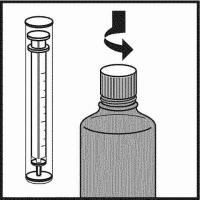 | 1. Remove oral dosing syringe from its protective case. Push down and twist child resistant closure to open bottle. |
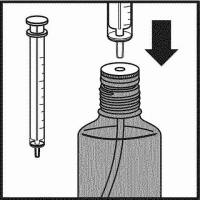 | 2. Insert tip of syringe into opening of white stopper. |
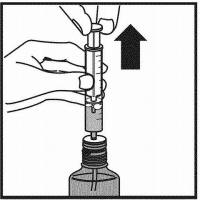 | 3. While holding the syringe, pull the plunger up to the level (see markings on side of syringe) that equals the dose prescribed by your doctor |
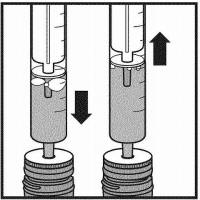 | 4. Before removing syringe containing prescribed dose from bottle, push out large bubbles by moving plunger up and down a few times. After the large bubbles are gone, pull the plunger again to the level that equals the dose prescribed by your doctor. Do not worry about a few tiny bubbles. This will not affect your dose in any way. Remove the syringe from the bottle. |
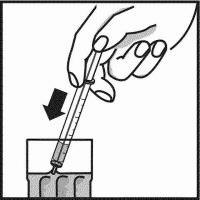 | 5. You may swallow Exelon Oral Solution directly from the syringe or mix with a small glass of water, cold fruit juice or soda. If mixing with water, juice or soda, be sure to stir completely and to drink the entire mixture. DO NOT MIX WITH OTHER LIQUIDS.
|
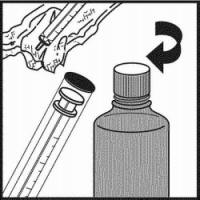 | 6. After use, wipe outside of syringe with a clean tissue and put it back into its case. Close bottle using child resistant closure |
Store Exelon Oral Solution at room temperature (below 77°F) in an upright position. Do not place in freezer.
Capsules manufactured by:
Novartis Farmacéutica S.A.
Barcelona, Spain
Oral Solution manufactured by:
Novartis Consumer Health, Incorporated
Lincoln, Nebraska 68517
Distributed by:
Novartis Pharmaceuticals Corporation
East Hanover, New Jersey 07936
Exelon patient information (in plain English)
IMPORTANT: The information in this monograph is not intended to cover all possible uses, directions, precautions, drug interactions or adverse effects. This information is generalized and is not intended as specific medical advice. If you have questions about the medicines you are taking or would like more information, check with your doctor, pharmacist, or nurse. Last updated 6/06.
Source: Novartis Pharmaceuticals, U.S. distributor of Exelon.
APA Reference
Staff, H.
(2008, December 1). Exelon: Cholinesterase Inhibitor, HealthyPlace. Retrieved
on 2025, November 26 from https://www.healthyplace.com/alzheimers/medications/exelon-cholinesterase-inhibitor

